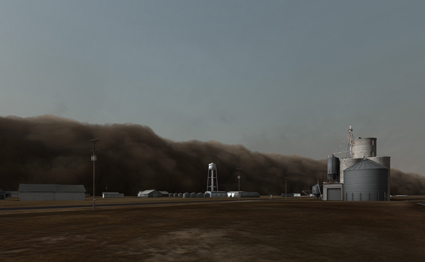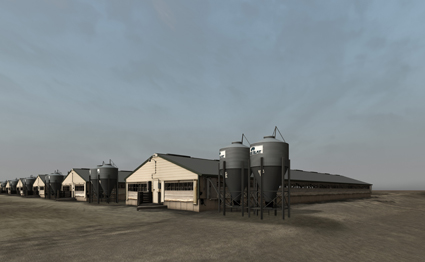into the void: nature distilled
urszula dawkins: john gerrard, pica

John Gerrard, Dust Storm (Dalhart, Texas), 2007, 2007, Realtime 3D
courtesy of the artist, Simon Preston Gallery, New York and Thomas Dane Gallery, London
John Gerrard, Dust Storm (Dalhart, Texas), 2007, 2007, Realtime 3D
THE LANDSCAPE HAS THE SPOOKY UNINHABITEDNESS OF THE COMPUTER GAME, AND THE SHIFTING VIEWPOINT OF THE SIMULATOR—BUT SLOWED DOWN TO A PACE AT WHICH PIXELS SCRATCH AT THE GAZE. ACROSS THE YELLOW-BROWN PRAIRIE RUNS A BITUMEN ROAD, EDGED BY POWER POLES AND LOOSE-SLUNG WIRES. THE VIEW SHIFTS TO REVEAL A MONUMENTAL SET OF FARM BUILDINGS, LIKE THE ANTITHESIS OF A SIMS GAME, AHEAD OF A MOUNTAINOUS FRONT OF CHOCOLATEY DUST. THE COLOURS, THOUGH REALISTIC, ARE RINSED WEIRDLY CLEAN. SILOS STAND LIKE SCI-FI WAR MACHINES, SENTINEL; THE SKY IS FEARFULLY WHITE.
Irish artist John Gerrard’s Dust Storm (Manter, Kansas) (2007) is part of his Animated Scenes series, four of which were shown recently at PICA. Constructed from thousands of still photographs, Gerrard’s ‘portraits’ are fully animated models, locked to a real-time schedule of changing light over the duration of the day. The viewer is drawn around both object and horizon in a stately, 360-degree orbit.
The images of dustbowl landscapes reference an astonishing history: the USA’s Black Sunday of 1935, when a dust storm 1,500 miles wide and half a mile high roiled and churned across much of Colorado, Kansas and New Mexico. The result of over-ploughing, the storm carried the topsoil of 100 million acres—a phenomenon made possible by the internal combustion engine. The storm took four hours to pass in some places; there are few photos of the apocalyptic event. To recreate it, Gerrard used photos taken by US troops in Iraq, of literal ‘desert storms’ passing over military bases.
The second work, Dust Storm (Dalhart, Texas) (2007) is even more epic and menacing, its group of farm buildings huddled in the far distance, insignificant before the advancing front. But as the view pans away from the storm itself, the threat vanishes. A dichotomy appears between the seething, chthonic cloud of grit and wind, and an idyllic, if sparse, pastoral scene.
The ubiquitous row of telegraph wires seems almost out of place here, as though there should really be no linkage between the cluster of distant equipment and the monstrous storm, or even indeed with the viewer. It’s a feeling that resonates with John Barrett-Lennard’s catalogue essay description of Gerrard’s works as floating in “a space between the real and imaginary, connected but apart from both.”
In his artist talk at PICA, Gerrard showed a photograph titled Figure Blocking Sun (Cesar) (2008). It features the silhouette of a man: an utterly black shape surrounded by a fine rim of backlight. Relating it to the Animated Scenes series, Gerrard spoke of the figure as void; of its form as an “oscillation between surface and portal.” As Barrett-Lennard points out, “however precise the rendering [of Gerrard’s images, their] reality is incomplete and a haunting emptiness remains.”

John Gerrard, John Gerrard, Grow Finish Unit (Near Elkhart, Kansas), 2008
photo Tony Nathan/Imagelab, courtesy the artist and PICA
John Gerrard, John Gerrard, Grow Finish Unit (Near Elkhart, Kansas), 2008
Gerrard’s Grow Finish Unit (near Elkhart, Kansas) (2008) presents an ominous array of low, grey-roofed buildings, whose eerie uniformity accentuates the silence of his works: no bird sings, no machinery hums. The term “grow finish unit” is a euphemism for an indoor pig farm, and the unnaturally still lagoon aligning with the sheds is, Gerrard points out, an effluent pond.
At the end of each shed are what seem to be extractor fan vents: large metallic cylindrical attachments, which, like squid suckers, lend an unsettling organic feel to the oddly warm cream and grey of the buildings. There is no opportunity to move the controls and enter. The paired feed silos that appear between sheds are strangely anthropomorphic, as though the viewer can’t help but place a figure here. Tellingly, it’s a figure that seems to ward off intruders.
Gerrard’s animations defeat the logic of the gaming engine he uses to create them, disabling the viewer from forging their own pathway through the work. The relentlessly orbiting ‘eye’ sometimes moves excruciatingly slowly, forcing reflection on these monuments to an environmental wealth that’s come at the price of desolation. The nodding oilfield Lufkin pumpjack of Lufkin (near Hugo, Colorado) (2009), like a huge, thirsty bird, is the most prosaic and familiar of the structures we observe, but seems the most irreal; perhaps because we are close enough to observe its subtle dislocation from the photographic image, the lack of minute detail rendering it smoothly alien. Gerrard describes it as “parasitically vasomorphic—reminiscent of the 20th century”—his own century, he says; a kind of self-portrait.
By eliminating surface distractions, John Gerrard’s ‘portraits’ distill both the human presence and the post-industrial ‘naturalness’ of the landscapes they recreate. It’s an uncanny blend of computer age and lost romanticism, which leaves the viewer oscillating in an intriguing void-portal space.
PICA: artist John Gerrard, production Werner Poetzelberger, modelling Daniel Felsner, programming Helmut Bressler, Matthias Strohmaier, additional modelling Christina Pilsl, additional programming Helmut Bressler; Perth Institute of Contemporary Art, Feb 17-April 3
RealTime issue #102 April-May 2011 pg. 46






